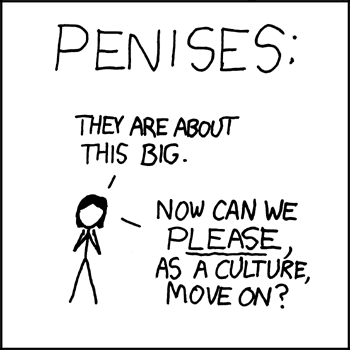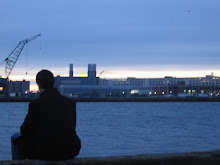
So can we? Of course not. If I took all the thought that I devote to my penis, and applied it to something useful to society, there'd probably be no more cancer.
When I stumbled across an archaic post of PZ Myers' on his Pharyngula blog, my subconscious was ecstatic with glee. Finally, another excuse to focus on my penis!
The gist of PZ's post is that research seems to suggest that while across different species, sexual selection shows a consistent pressure towards larger size in male genitalia, the varying effect of natural-selection pressures will drive size down.
The burden of bearing a massive penis
A couple of recent studies in fish and spiders have shown that penis size is a matter of competing tradeoffs, and that these compromises have evolutionary consequences. Guys, trash that e-mail for penis enlargement services—they can make you less nimble in pursuit of the ladies, or worse, can get you killed.[....]
[....]The authors measured [the spiders'] peak speed in short sprints, and found that it shot up from 2.7±0.2 cm/s to 3.8±0.3. They also had impressive improvements in endurance. They'd chase spiders with a soft brush until the poor fellows collapsed in exhaustion and would move no more. Spiders with two intact pedipalps [dual spider-cocks] would flop down after 17 min 30 s±55 s. Lose one palp, and they could keep running for 28 min 30 s±45 s. Even more severe, spiders with two palps died.53% of the time after collapsing, while the unipalp runners only died 12% of the time[....]
[and now for the fish-dick portion!][....]Given a choice, females flirted with the large-gonopodium male 81% more often than the small-gonopodium male. You knew that would be the case, didn't you?
[...]That advantage doesn't come for free. They also measured burst-speeds in startle-escape responses, the fast tail-flick dart fishes use to get away from the lunge of predators…and the large-gonopodium fish were significantly slower. That large object hanging off the fish represents a good bit of drag, reducing speed, maneuverability, and endurance, and may also be something to catch the eye of predators.
This study went a step further and looked to see if gonopodium size has consequences in the real world. They sampled populations from lakes and ponds that were either free of piscivorous predators (the open bars in the chart below), or contained beasts that would chow down on Gambusia (the black bars), and measured gonopodium size. Males in predator-free waters had gonopodia that were on average 12% larger than their more harried conspecifics.
The lesson is clear. If you live in an environment where you can afford to be slow and lazy, sexual selection can take over: the females will preferentially mate with the fish with the larger gonopodia, driving up the average size over generations. If you have to be nimble and swift to stay alive, natural selection will cull out the males with oversized genitals.
Genital size can vary between localized groups within the same species based on how much pressure is exerted by natural selection and the ability to be nimble and swift.
Does that really seem to transfer over empirically to humans?
A natural hypothesis to make would be that a population's genital size would be affected by how long ago that area switched from hunting and gathering to general agriculture.
There are probably few things that exert natural selective pressure towards being nimble and swift than hunting does, and any man that's ever run naked (or commando) knows that having your cock constantly slapping your thigh is a little impeding.
On the other hand, sustained agriculture would significantly reduce the effect of natural selection on the need for speed and agility.
You would expect that, in an area where humans have engaged in agriculture for hundreds of generations, you would see that sexual selection had outstripped survival pressures.
Where hunting and gathering had been the primary means of survival, you'd expect that natural selection would have, on average, a slightly diminishing effect on genital size.
Does the hypothesis hold up? Look at the difference between averages in Africa and Southeast Asia. I don't remember where I got this, but I remember reading somewhere that the averages differ between 10% and 20% (up to around an inch).
Southeast Asia has been engaging in regular agriculture for thousands of years, whereas humans were largely hunter/gatherers in Africa until more recently. Yet it's people of African descent that average slightly more than their Asian counterparts.
Based on that alone, the hypothesis doesn't seem to hold up.
Then again, we're looking at only two data, and many potentially confounding variables. (Climate, clothing, diet, etc.)
Still, if the main factor determining male genital size really is the surival pressure of speed and agility, then you would expect that pressure to outweigh any others.
Or maybe several thousand years don't leave enough time for differences in importance between natural selection and sexual selection to affect heritable phenotype.
hehehe... Penis.


No comments:
Post a Comment